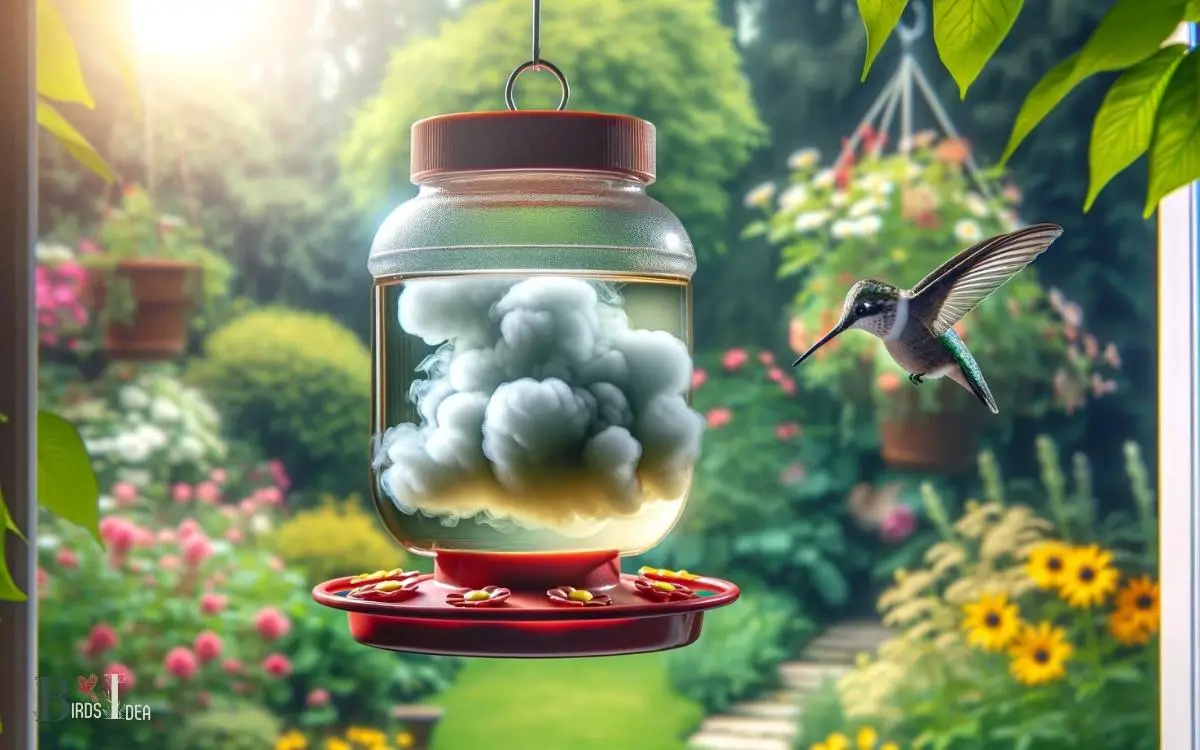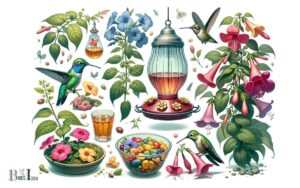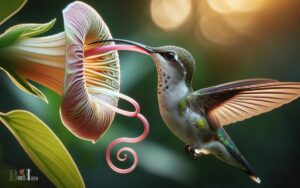Why Is My Hummingbird Food Cloudy? Discover!
Cloudiness in hummingbird food often indicates bacterial or fungal growth, which can occur due to various factors such as unclean feeders, organic debris, or using tap water with high mineral content.
To maintain clear and healthy nectar, it is essential to regularly clean feeders, boil the sugar solution, and use purified or distilled water.
Hummingbird food becomes cloudy primarily due to:
To prevent cloudiness:
- Clean feeders with hot water and vinegar.
- Change food every 2-3 days, more often in hot weather.
- Use a 1:4 sugar-to-water ratio for the nectar.
- Boil the nectar to help inhibit bacterial growth. – Use purified or distilled water to prevent mineral deposits.
Keep hummingbirds healthy with crystal-clear nectar by ensuring meticulous feeder hygiene and using the right water and nectar recipe.

Key Takeaway
Improper Storage
Infrequently, cloudy hummingbird food results from improper storage practices, which can lead to fermentation and spoilage.
Proper storage of hummingbird food is crucial in maintaining its quality. When preparing the nectar, it is essential to store any excess in a clean, airtight container.
Exposure to air can lead to fermentation, causing the sugar in the solution to break down and spoil.
Additionally, exposure to sunlight can also lead to spoilage, so it’s important to store the nectar in a cool, dark place. Furthermore, any leftover nectar should be refrigerated to prevent spoilage.
By ensuring proper storage practices, you can maintain the clarity and quality of the hummingbird food, providing a safe and healthy source of nutrition for these delightful birds.
Moving on to the subsequent section about ‘contamination’
Contamination
Contamination of hummingbird food can lead to mold and bacteria growth, posing a risk to the health of the hummingbirds.
Proper cleaning and sterilization of feeders and containers is essential to prevent contamination and ensure the safety of the food provided to the hummingbirds.
Maintaining a clean and hygienic feeding environment is crucial for the well-being of these delicate birds.
Mold and Bacteria Growth
Mold and bacteria growth in hummingbird food can occur when proper sanitation practices are not followed.
It is crucial to maintain cleanliness throughout the entire hummingbird feeder and food preparation process.
Mold can develop in the sugar solution if the feeder is not cleaned and refilled every 2-3 days, especially in warm weather.
To prevent bacteria growth, ensure that all equipment used for making and handling the nectar is thoroughly cleaned and sanitized.
Use hot water and a small amount of vinegar or a mild bleach solution to clean the feeder, ensuring that all parts are rinsed thoroughly before refilling.
Additionally, store any unused nectar in the refrigerator to inhibit bacterial growth. By maintaining strict sanitation practices, you can ensure that your hummingbirds are provided with safe and healthy food.
Cleaning and Sterilization
Proper cleaning and sterilization are essential for preventing contamination in hummingbird food. Regular cleaning of feeders, bottles, and utensils is necessary to ensure the health and well-being of the hummingbirds.
Here are some recommended cleaning and sterilization practices to maintain a safe environment for these delicate creatures:
| Cleaning Step | Method | Frequency |
|---|---|---|
| Disassembly | Take apart all parts | After every refill |
| Rinsing | Use hot water | Before every refill |
| Soaking | Use mild bleach solution | At least once a week |
| Scrubbing | Use bottle brush | At least once a month |
Following these cleaning and sterilization practices will help prevent the growth of mold, bacteria, and other contaminants, ensuring that the hummingbirds have access to clean and safe food.
Natural Fermentation
Natural fermentation is a common cause of cloudiness in hummingbird food. This natural process occurs when the sugar solution is left out for an extended period, leading to the growth of yeast and bacteria.
Understanding the impact of natural fermentation on hummingbirds and implementing preventative measures is crucial for maintaining the clarity and quality of their food.
Cloudiness in hummingbird food can be attributed to the natural fermentation process. When making homemade nectar, it’s important to understand that natural fermentation can lead to cloudiness due to the breakdown of sugars.
This can occur more rapidly in warm weather. To ensure the best quality for our delicate hummingbird friends, it’s crucial to be mindful of the causes of cloudiness and take proactive steps to prevent it.
The table below outlines the key causes of cloudiness in hummingbird food, along with practical solutions to address each issue.
| Cause of Cloudiness | Impact | Solution |
|---|---|---|
| Natural Fermentation | Decreased nutritional value for hummingbirds | Store nectar in a cool, dark place. |
| Contaminated Equipment | Harmful to hummingbirds and not appetizing | Regularly clean and sterilize feeders. |
| Spoilage | Potential health risks for hummingbirds | Replace nectar every 3-4 days. |
Understanding these causes can help us ensure that our hummingbird food remains clear and safe for consumption. This is essential for providing the best care for our tiny, feathered friends.
Transitioning to the subsequent section about ‘impact on hummingbirds’, it’s crucial to understand how cloudy hummingbird food can affect these delicate creatures.
Sugar-to-Water Ratio
Achieving the proper sugar-to-water ratio is essential for maintaining clear and healthy hummingbird food.
The recommended ratio is four parts water to one part sugar, as this closely mimics the sucrose levels found in natural flower nectar.
This ratio provides the necessary energy for hummingbirds while also ensuring that the solution is not too concentrated, which can harm the birds.
Using less sugar can lead to microbial growth, causing the food to become cloudy and potentially harmful to hummingbirds. On the other hand, using more sugar can dehydrate the birds.
It’s crucial to measure the ingredients precisely and boil the mixture to ensure the sugar is fully dissolved.
By maintaining the correct sugar-to-water ratio, you can provide a safe and nutritious source of food for these delightful creatures.
Mold Growth
Maintaining proper cleanliness and storage of hummingbird feeders and food is crucial in preventing mold growth.
Mold can pose a threat to the health of hummingbirds, so it’s essential to take steps to minimize its occurrence.
To prevent mold growth in hummingbird food, consider the following:
- Cleanliness is Key
- Regularly clean feeders with hot water and a bottle brush, ensuring that no sugar residue remains.
- Choose feeders that are easy to disassemble for thorough cleaning.
Sunlight Exposure
Proper sunlight exposure is essential for maintaining the cleanliness of hummingbird feeders and preventing mold growth in the food.
When positioning your feeder, it’s important to find a balance between providing adequate sunlight for natural sanitization and minimizing exposure to excessive heat, which can cause the nectar to spoil more quickly.
Here’s a guide to help you determine the best placement for your feeder:
| Aspect | Recommendation |
|---|---|
| Morning Sun | Place the feeder where it receives morning sun, as this helps to dry up any moisture that may have accumulated overnight. |
| Afternoon Shade | Ensure the feeder is shaded during the hottest part of the day to prevent the nectar from overheating and spoiling. |
| Dappled Shade | If possible, position the feeder in an area with dappled shade to protect it from intense, direct sunlight. |
| Regular Cleaning | Regardless of sunlight exposure, remember to regularly clean and refill the feeder to maintain the freshness of the nectar. |
Temperature Fluctuations
To ensure the cleanliness and freshness of hummingbird food, it is important to consider the impact of temperature fluctuations on the nectar’s longevity and quality.
- Rapid temperature changes can cause the nectar to spoil more quickly and may lead to cloudiness.
- Extreme heat can cause fermentation, while cold temperatures can cause the nectar to crystalize and become unappealing to hummingbirds.
Conclusion
The cloudiness of hummingbird food can be caused by improper storage, contamination, natural fermentation, sugar-to-water ratio, mold growth, sunlight exposure, and temperature fluctuations.
It is important to properly store and monitor the hummingbird food to ensure its clarity and quality.
Like a clear spring day after a storm, clear and vibrant hummingbird food will attract and nourish these beautiful creatures in your garden.






